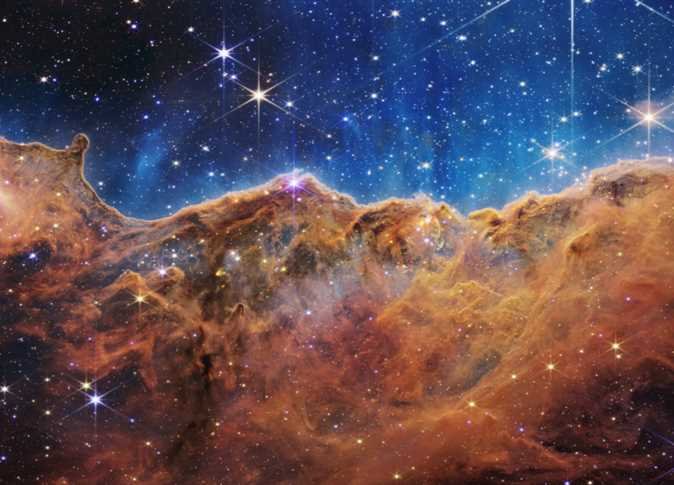Sky watchers in Egypt and the Arab world are preparing to observe the encounter of Mars this evening, Wednesday, December 7, 2022, as the face of the planet will be fully illuminated by sunlight, clearly and distinctly visible to the naked eye after sunset and first night, and will be near full moon conjunction all night long.
And the Jeddah Astronomical Society revealed in its report that the Mars encounter phenomenon is worth monitoring because this planet is in its best shape right now and is the only one whose surface details can be seen from Earth. , it’s very small and the other planet is covered in clouds, so this is a great event for everyone.
Mars will be at its brightest and best as the sun illuminates the entire disk of Mars and will reach its maximum brightness for this year (-1.9) apparent to the planet last May, because Mars has reached its closest to Earth in early December.
The report continued: When viewing Mars with the naked eye, it will appear as a bright orange point of light, and when using binoculars, it will also appear as a point of light with no clear features, completely as if you were looking at it with the naked eye. Therefore, binoculars are not suitable for observing Mars.
The phenomenon of the encounter with the planet Mars is a relatively rare event, as it occurs every two years, and during this period the planet appears bright so it is very easy to find it and distinguish it from other celestial bodies, especially in the encounter where will find appear as a bright red dot in front of the constellation Taurus, precisely among the stars that make up one of the bull’s “horned” stars.
Encountering Mars also represents half of the best time to see the planet, and occurs approximately every 26 months. During this time, the earth is between Mars and the sun, and Mars faces the sun in the sky, as will appear above the northeastern horizon at sunset and reaches its highest point in the southeast at mid-Night.
Note that not all Mars encounters are equal, as both Mars and Earth’s orbits are elliptical, so some encounters between the two planets are closer together than others, and this occurs in the form of groups of twos and threes meeting each other. they repeat in an average cycle of 15 to 17 years.
The encounter with Mars takes place this year 2022, coinciding with the closest point to perihelion during the next ten years, at a distance of 80 million km from the Earth, and therefore will be the best encounter until the year 2033.
Another astronomical phenomenon will coincide with the encounter of Mars, as residents of North America, Western Europe and Northwest Africa will have the opportunity to see the occultation of Mars behind the moon, in a wonderful scene.
During the 2022 Mars encounter, both polar regions can be seen through a medium to large telescope. However, you won’t see the ice domes: the northern ice dome is now covered by a thick layer of clouds, while the southern cover has shrunk dramatically during the summer season.
In general, Mars is the only planet whose surface is visible in detail from Earth. However, it is a small planet, about twice the size of the Moon and about half the size of Earth. It often spends most of its time away from other part of its orbit from Earth, and usually appears as nothing more than a simple featureless orange dot, but upon encountering marks can be seen on its surface, polar dome, and clouds.
The best telescope for planetary observing is a large refractor or long focus reflecting telescope, but any good telescope can make observations of this planet. The important factor is usually the stability of the atmosphere, which can change from hour to hour. time and affect the image quality.
Using a 4 or 6 inch telescope, and for clear skies and still air, you may be able to see the northern ice cap, dark surface markings, clouds and dust, and when using a Magnification 105, make the disk of Mars appear the same angular size as the moon appears to the naked eye.
It is preferable to use an 8-inch Dobsonian telescope with a Newtonian design, and the reason is that it is easy to use and portable. It is preferable to have the same telescope with a size of 10 inches or even 16 inches.
Color filters can also be used to enhance monitoring. A wide range of color filters are suitable, for example a green or blue filter will enhance the polar caps and a red or orange filter will enhance dark detail.
Mars will reach the moment of convergence on the morning of Thursday 08 December 2022, at 09:00 Mecca time (06:00 GMT).
After meeting Mars, its brightness will begin to decrease day by day, then fade by the end of the month, and every night the red planet will soon appear on the horizon.
It is worth noting that the next encounter with Mars will take place on January 16, 2025, but the distance separating the Earth from the Red Planet will be greater, so it will appear slightly fainter and its angular size smaller in the sky, and this is one reason why more so as not to miss the meeting with Mars in 2022.


